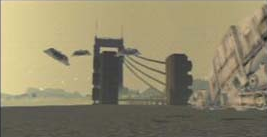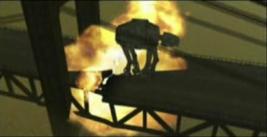![]()
Announced shortly after the release of the Nintendo 64, with the more familiar name of “Turrican 64“, Thornado was meant to be the first 3D game in the Turrican series, but with a different name because of some copyright problems. From the first N64 concept, which development was confirmed several times by Factor 5 in different interviews, there are not many informations, apart from the rumor that it was going to be even more inspired by the exploration-structure of Metroid. Like several other N64 titles, Thornado 64 was soon cancelled and its development started again for the new Nintendo console, at the time still known as the”Project Dolphin“.
At the Space World 2000 Thornado was finally presented in a real time demo-video at closed doors for few gaming journalists. In that video, the hero of the game was trying to escape from an explosion, running on a huge bridge while the cars and the street itself were flying in the air. Unfortunately this video was never released and neither has any screenshots from the game: only some concept arts were saved to preserve the existence of this cancelled project.
Few details on the game are available: as announced for the 64-bit version, Thornado should have been inspired by Metroid, combining a third person shooter action with exploration, two playable characters (a man and a woman), the return of the “hookshoot” and futuristic setting from the classic Turrican. As noted by Ross Sillifant, Thornado WAS planned to be a GameCube LAUNCH title after N64 version was cancelled, see ‘whatever happened to Turrican?’ Arcade Mags Timewarp July 1998 feature.
Is still unknown why Thornado was never released, but maybe the various Star Wars projects that Factor 5 developed for the GameCube were one of the reasons. F5 were too busy to work on those profitable Star Wars games, to think about finishing Thornado.
An interesting note: in a level of Star Wars: Rogue Squadron 3 (Defenders of Ralltiir) for the GameCube, Factor 5 have added a small tribute to Thornado. Infact the great bridge in this mission is the same bridge that was modeled for the Thornado Tech Demo! Below you can see some screenshots of the Ralltiir bridge, so we can have a vague idea about the Space World 2000 Thornado video.


Images:






